Video Marketing: How to Run an Effective Strategy in 2022
There’s nothing new about using videos for marketing. But what differentiates a good marketing video from a bad one?
A strategy.
Much like any other content type, videos should have a goal and target a specific audience. Then, you can be sure your investment in video marketing is not a waste of money.
Don’t know how to introduce videos to your business the right way?
We’ve got you covered with this comprehensive guide. Here’s what you’re going to learn:
- What video marketing is and the benefits it brings.
- How to create a proper plan.
- Top trends in 2022.
We will also share some of the best-performing video types for each sales funnel stage and introduce the metrics and KPIs which are absolutely vital for the success of your strategy.
Disclaimer: The information below is accurate as of today, December 1, 2021.
What is Video Marketing?
Video marketing is a content marketing strategy that aims to boost audience engagement, promote a product or service, or raise brand awareness using video content.
Benefits of video marketing for business
Video content consumption increases every year. Statista’s global survey has revealed that most respondents (27.2%) spend over 10 hours a week watching videos.
But is it a good enough reason to invest in video marketing? After all, creating videos can be costly.
To put all your doubts to bed, here are a few solid reasons videos appear regularly in your content marketing strategy.
1) More revenue
Videos are notoriously expensive to make. But it doesn’t mean that this investment doesn’t pay off.
According to the State of Video Marketing 2021 Survey by Wyzowl, 8 out of 10 marketers say that videos positively affect sales. Additionally, 87% of the respondents say video content gives them high ROI.
2) A higher position in the SERPs
If you’re struggling to bring your brand to the top of the search results, video content marketing can help you with that.
Video marketing statistics by Insivia state that a web page with a video is 53 times more likely to get to the first page of Google. The reason is simple—videos make your snippet look more prominent and more noticeable.
3) More traffic
Video content helps you rank higher. And it also drives organic traffic to your website.
Wistia’s study has revealed that videos increased the website’s organic traffic by 10.6%. This percentage can get even higher if you commit to a video strategy long-term.
4) Better brand recognition
Video marketing for businesses also delivers great brand awareness results.
According to PR Newswire, 53% of marketers successfully use videos for brand recognition, all thanks to video content’s ability to drive engagement.
5) Better relationships with customers
Finally, videos give you an excellent opportunity to showcase your expertise as a brand and build authority in your niche. And, if done successfully, video marketing can bring you closer to your customers.
The same report by PR Newswire mentions that 52% of marketers successfully use videos to build trust with their clients, as well as to educate and inform.
How to Create a Video Marketing Plan
Videos bring engagement, revenue, and boost brand awareness—you get the idea. But it’s all theoretical.
In reality, however, a lot depends on your plan. Sure, you can rely just on your creativity, but it’s unlikely your video will deliver the results you expect.
So, let’s continue our guide with a step-by-step process of creating a proper strategy. We’ll also share some video tactics.
Step #1: Set video marketing goals
Every marketing strategy starts with setting goals, and digital video marketing is not an exception. And a good goal is specific, measurable, and resource-based.
How do you reach these criteria?
Consider the sales funnel stage you want to target with your video. There are three primary sales funnel stages:
- Awareness. At this stage, the buyer realizes they have a certain problem and need a solution to fix it. The goal is to introduce your brand and briefly show how you can solve their problem.
- Consideration. Your customer is aware of who you are, knows that you can cater to their needs, but is looking to learn more. The goal of your video marketing strategy at this stage is to inform and educate.
- Decision. At this point, a customer is comparing your services against your competitors and weighing the pros and cons of your product. Your goal is to put forward all the advantages of your brand and product to persuade the customer.
You can find video ideas for each sales funnel stage in the next chapter.
When you know which sales funnel stage you want to target, consider the resources you have for your video and how you will measure your video marketing efforts. You should know from the beginning which metrics will indicate if your video has reached its goal or not.
Step #2: Define your target audience
One more factor in setting your goal is the buyer persona. Like with any other content, videos can’t be “for everyone”—you should target a specific audience with a particular need.
The description of a buyer persona consists of two components:
- Demographics: age, gender, location, language, occupation, marital status, income, education, etc.
- Psychographics: needs, interests, hobbies, challenges, etc.
If you run a B2B company, you should also add more detailed information about the target buyer’s occupation—industry, size of the organization, job title, job responsibilities, goals, etc.
Where can you find this information?
LinkedIn Analytics can come in handy. It categorizes your followers according to their job position and the industry they work in:

You can also run a survey to find out about job responsibilities, career goals, and other details.
Your final task is to identify your target buyer’s paramount need and explore how your product or service can cater to it. Once you have that figured out, you can move to the next step.
Step #3: Get marketing video ideas
The next step in our guide is to get ideas for video content. And there are two main resources for inspiration.
First, you can do some competitor research and find out what your rivals’ video marketing strategies are.
You have two types of competitors:
- Direct: companies that have a similar audience and product (Walmart and Target).
- Indirect: brands that offer slightly different products but target the same audience with the same need (Adidas and Timberland).
Search for the companies with similar products on the market and check out their video marketing campaigns. Here’s what you should be looking for:
- Types of marketing videos for business.
- Their audience’s engagement level for each video.
- The frequency of new video content publishing.
These details are enough to figure out video ideas that work well for your competitors. But don’t just rip off their strategies; think, how you can improve them to make your video a better fit for your audience’s needs.
If competitor research is not enough, search for trending topics on the web. At this point, Google Trends can come in handy. Simply type the keyword for the trend you’re interested in and check its performance:
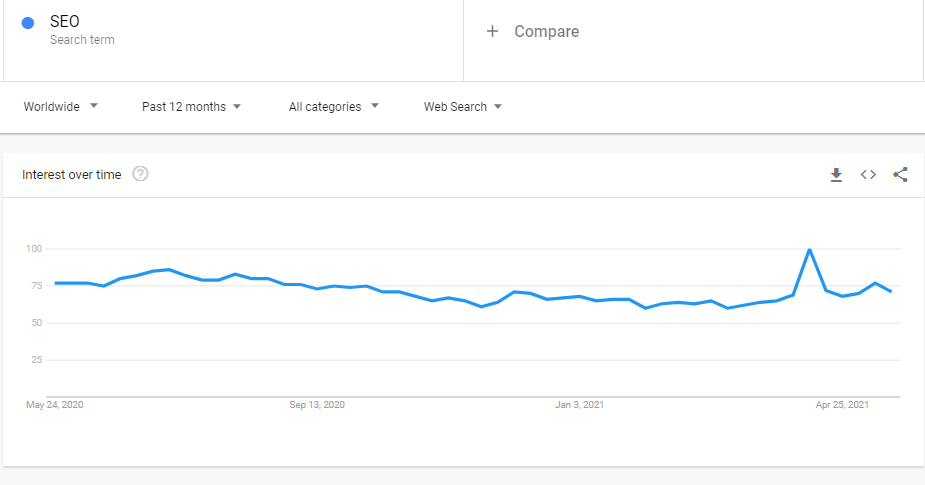
You can also look for hot trends on social media. For instance, trending topics on Twitter get updated several times a day:
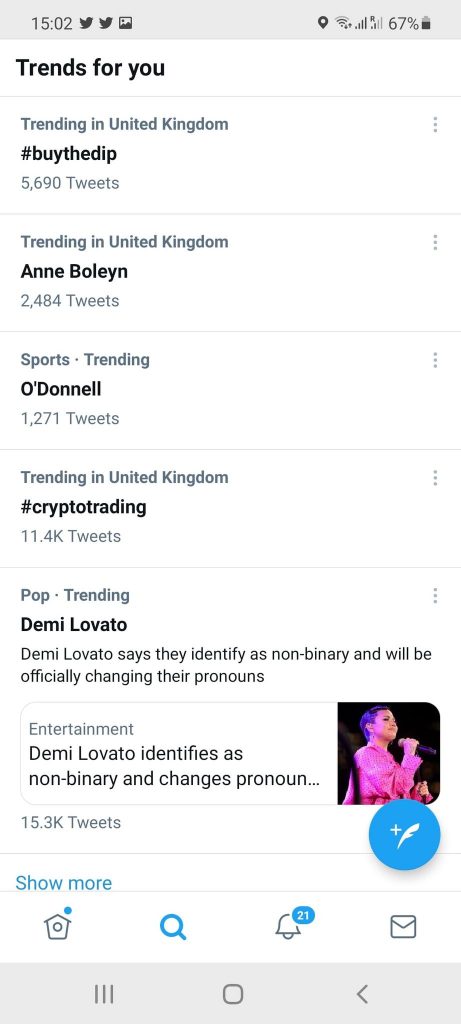
Trending topics on social media and on the web, in general, can also be a great source of viral video ideas.
Step #4: Outline your budget
We’ve already mentioned that videos can be quite expensive. But what should you take into consideration when calculating your video marketing strategy budget?
Here are a few essentials for a high-quality video:
- Filming equipment (camera or phone)
- Audio equipment (microphones, audio mixers)
- Lighting equipment (key light, fill, backlight)
- Video editing software
- Miscellaneous (SD cards, tripods, green screen)
Additionally, you might need to rent a studio if you’re looking for a specific set for your video. Another thing to consider is hiring a videographer responsible for filming the video and editing the footage.
Of course, there’s always an option to reach out to a video production crew. This way, you won’t have to purchase equipment or rent a studio. However, if you’re building a long-term video marketing strategy, it makes sense to invest in your own filming equipment.
Step #5: Create a content calendar
Before you create a marketing video, add a content calendar to your plan. A content calendar is a publishing schedule you’ll use to plan your production process and ensure your video content is ready on time.
A proper video calendar should have:
- Deadlines (when the video should be ready)
- Publishing dates (not the same as deadlines—you should have time to revise videos a few times)
- Campaign names
- Topics
- Video types
- Task owners
- Video distribution channels
If you’re planning a long-term video marketing strategy, you can categorize your content calendar according to the sales funnel stages.
Step #6: Choose the channel to distribute your video
The last thing to consider before filming is video promotion, and there are three distribution channels you can choose from:
- Owned: blog, website, email.
- Paid: social media ads, search ads, influencer marketing, native ads.
- Shared: social media platforms and channels where you can upload videos but have to comply with third-party policies.
If you’re just starting with video marketing, you should put all three channels to use and then figure out which one brings the biggest return. But if it’s not your first rodeo, use the channel that resonates best with your target audience.
10 Types of Videos to Use at Every Sales Funnel Stage
Marketing videos can do wonders to brand awareness and recognition, in theory. In reality, if the video doesn’t match your audience’s needs at each sales funnel stage, even the most immaculate video marketing strategy can fail.
To avoid that, the best practice is to look at what video types other companies use at different sales funnel stages and learn from their success. Here are a few ideas and examples of videos for marketing to inspire your strategy.
Awareness stage
1. About Us videos
An About Us video (a company culture video) communicates the idea and the goal behind your brand to the world. Basically, you’re introducing your company to your target audience. HubSpot engaged its CEO in an About Us video to tell the story of the company and how it was founded:
This video type will fit in your strategy well if your goal is to get the audience acquainted with your brand and company culture.
2. Brand documentaries
A brand documentary touches upon the company’s establishment and growth. While an About Us video briefly introduces your company to the customer, a brand documentary offers a deeper look into the idea behind your brand.
You can either make a short movie documenting the journey of building your company or create a video on your brand’s main values and their importance for your customers, like InVision did with its Design Disruptors docu-series:
InVision’s documentary tells about the role of design in the modern world using examples (and actual interviews) from top companies like Google, Pinterest, Evernote, Mailchimp, Twitter, etc.
Such a documentary both raises brand awareness and works as a way to persuade InVision’s future customers that they are dealing with a knowledgeable and authoritative agency.
3. Product overviews
A product overview is a marketing video that introduces a potential customer to the product and briefly describes its main perks and features.
A good product video should:
- Cater to your target audience.
- Address a specific need.
- Provide context.
- Show your product in action.
A great example of all these features combined is HubSpot’s Make My Persona tool overview:
This video showcases the features and benefits of the persona generator in just 33 seconds. It’s too short to show how the product works, but it’s enough to give a clear idea. That’s why product overviews are also great for video ads and email marketing.
4. Videos with employees
If you’re in B2B, many potential partners can be interested in learning how diverse your team is and how you build a relationship with your workforce. That’s why it makes sense to create a video with your employees and use it on the awareness stage.
Datadog has a great example of such a video. In their preparation for International Women’s Day, the company has interviewed women of their company about why they love working at Datadog:
In general, involving employees in your videos shows you as an open and transparent brand and forms a positive first impression of you among potential customers.
Consideration stage
1. How-to videos
A how-to video gives a deeper look into one of your product’s features. Also known as explainer videos, how-tos are the most common among video marketing examples.
Tidio has a great how-to video talking about a specific product feature—setting up Tidio’s chatbot on a Shopify website:
This video is a terrific example of a product walkthrough, which can come in handy to educate your customers on how the product works and ways to set it up.
2. Expertise videos
Expertise videos are similar to how-to videos in that they also feature your product but mostly focus on a specific need and how your solution can help with it.
Take a look at how SEMrush is using expertise videos. The brand has created an entire knowledge base covering how their platform helps with digital marketing woes:
The example above demonstrates how the viewer can create high converting landing pages and how SEMrush’s solution helps with that. As a result, SEMrush’s video both shares knowledge and promotes the product.
3. Testimonials and storytelling videos
Social proof matters: 92% of consumers say they look for online reviews before purchasing a product.
If you use videos featuring customer testimonials, you kill two birds with one stone by providing relevant social proof and raising brand awareness.
The best way to introduce customer testimonials in a content marketing video is through storytelling. SalesForce has a bunch of excellent video examples telling stories of their customers.
In the video below, SalesForce reveals how it helped Amazon Web Services acquire millions of loyal customers:
The video doesn’t explain how the brands achieved their partnership goals, but it features the people involved and their vision of why SalesForce is trustworthy.
Decision stage
1. Case study videos
A case study video illustrates the value of your product or its features using a real-life example. Usually, case study videos talk about a successful partnership with a client.
What’s the difference between a case study and a customer testimonial video?
Case study videos often show numbers and give a detailed description of the strategy that led your customer to success.
Here’s a good example of a case study video from SEMrush:
This video tells the story of Arkadium that used SEMrush’s solution to increase traffic by 850%. Arkadium also reveals the 6-step strategy that drove this amazing outcome.
As a result, this video both shows the possibilities of SEMrush’s product and, with the help of data and real-life examples, persuades the customers to buy it.
2. Virtual tours
We’ve talked about product overviews, how-to videos, and now it’s time to reveal the last version of these videos fit for the decision stage of the funnel—virtual tours.
A virtual tour is a full product walkthrough that covers your product’s features from A to Z.
Just take a look at Asana’s demo and product tour video:
It’s a twenty-minute tutorial on how to set up Asana in Japanese. Videos like this help customers compare solutions and decide which interface and functionality match their needs.
3. FAQs
FAQ videos answer the most common questions your new customers might have about your product. It can be animated videos or videos featuring your employees.
An FAQ video can help with conversion at the decision stage of a sales funnel. It is your chance to highlight the best perks of your product and put any doubt about it to bed.
For inspiration, you can check out the FAQ video by Matador Useful Goods:
It answers the main question regarding the company’s products (embroidery and textile goods). The video is just about two-minutes long, but it’s enough to provide all the necessary details that interest the target customer.
Trending Video Types for 2022
While the examples we described above will definitely remain relevant, there are some marketing video formats that will dominate the game in 2022.
Of course, we can’t dismiss the impact the pandemic has made on the way we consume video content. Its influence has definitely brought some video types forward. Some of these formats should definitely become regulars in your video marketing strategy.
Let’s take a look.
1) Live streams
Live streaming helped people stay in touch with their favorite brands during the pandemic. According to Adweek, streaming content on online platforms has eclipsed traditional pay TV in 2021, and the situation will remain the same in 2022.
What are the benefits of live streams for a business?
- Grow your audience. If you choose to go live on a streaming platform, anyone who finds the topic of your stream interesting can connect and participate in the discussion. As a result, you can expand your audience and get more potential customers.
- Save money. If your small business is on a budget, this video format is perfect as it doesn’t require pricey tools – all you need is a laptop and a mic.
- Get closer to your followers. Live streaming allows you to interact with people in real time, learn more about their needs and concerns and promptly address them.
Live streams are also pretty versatile and can take various formats. They are also not time-bound, and people can set a reminder to join the stream when it begins:
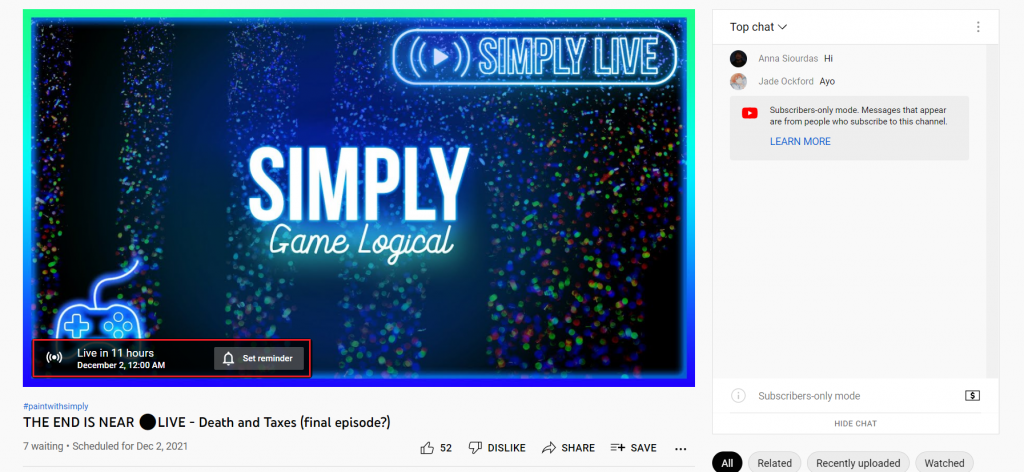
It’s also worth mentioning that, besides Twitch and YouTube, you can also go live on any social media platform.
2) YouTube Shorts
This video format has boomed in 2021 and is expected to remain popular next year as well. At its onset, the YouTube Shorts feature already got 3.5 billion views during its test run in India alone. Fascinating, isn’t it?
If you haven’t heard about this tool, YouTube Shorts allows creators to upload short videos made straight from their phones. Such vids don’t require editing, which is very handy.
What will you get by using YouTube shorts?
Here are some perks:
- Stay in touch with your followers.
- Drive engagement.
- Gain more exposure.
You can browse Shorts via the YouTube app:

Users can like and dislike these videos, add comments and share them.
3) Instagram Reels
Over the past years, the consumption of video content on social media has grown immensely. For instance, the majority of Gen Z-ers and Millennials report watching more vids on Instagram, Snapchat, etc.:
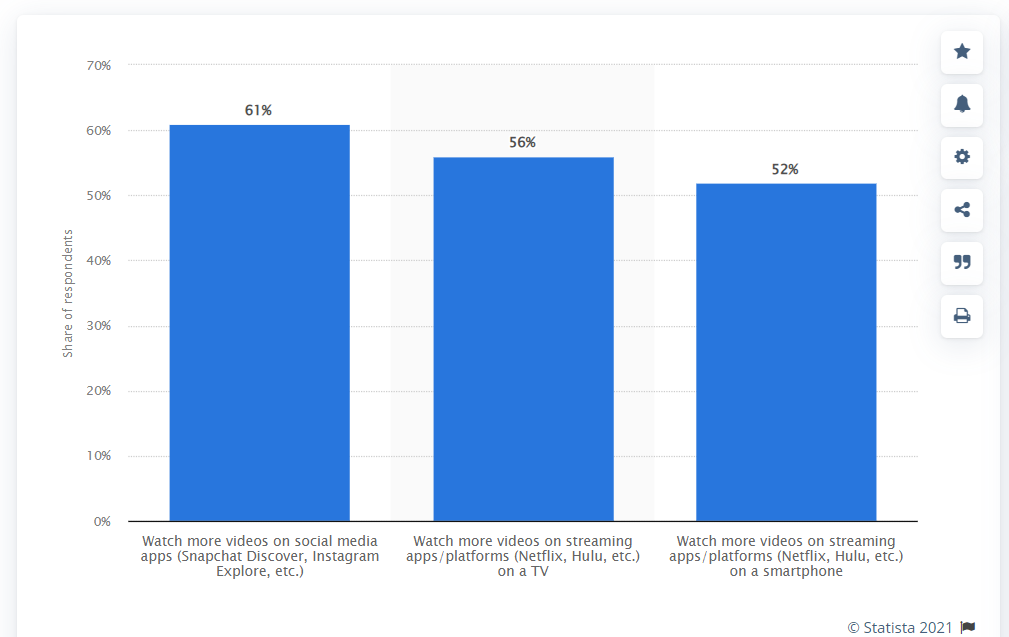
Such an interest in social media videos prompted Instagram to come up with Instagram Reels – a content type similar to what users post on TikTok.
Reels are 15-second clips that you can edit, adding cool effects and filters. Here’s how your business can benefit from using this video format:
- Improved discoverability. Reels appear in Instagram Explore, allowing more people to spot your brand and check out your content.
- Stronger connection with followers. Unlike Stories, Reels won’t disappear after 24 hours and are available for sharing at all times.
You can also use this video format as an opportunity to engage with your followers like Valeria Lipovetsky did, asking her subscribers to help clean out her closet:

You can also use Instagram Reels to diversify your video marketing strategy on social media by staying on-trend.
4 Video Marketing Best Practices
Having a creative idea for a marketing video is great, but there’s always a way to improve it.
How?
Here are five must-know practices that will make any video a success.
1) Consider most popular topics in your niche
The viewer engagement rate depends on how well you can match the topic of your video with your audience’s interests. That’s why it makes sense to study the hottest topics in your niche and use them in your videos.
The easiest way to find trending topics in a specific niche is to check out the People Also Ask section in Google search:

You can also go to related searches and see other topics relevant to yours:

Another trustworthy place to find relevant niche topics is Reddit. There are plenty of communities on this platform that discuss the issues you’re interested in:
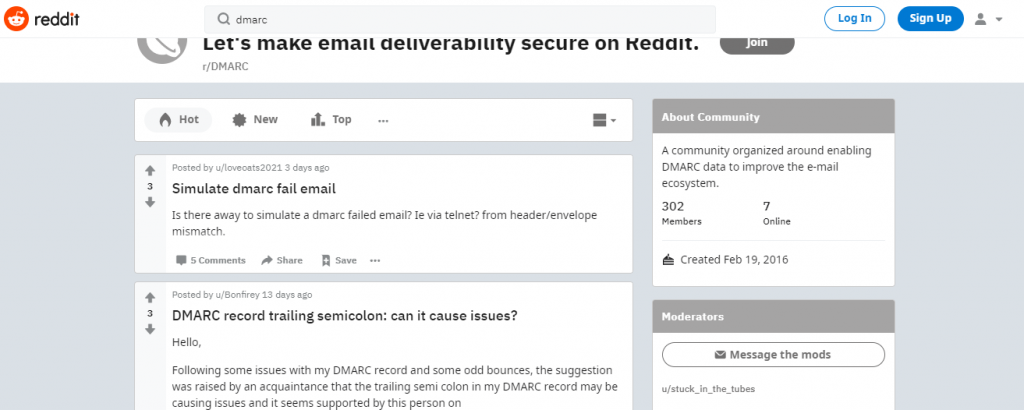
The topics you find via Google search and Reddit can yield good results when creating product overviews, how-to and expertise videos, case studies, virtual tours, and FAQs.
2) Make your videos short and straightforward
If you’re using video for marketing, there’s no time to beat around the bush. A potential customer comes to watch your video and find the answers they are looking for. So, the more straightforward your video is, the better.
Another important aspect of your video is its length. In theory, shorter videos perform better. A TechSmith study on video length has revealed that most viewers prefer three to six-minute-long videos:
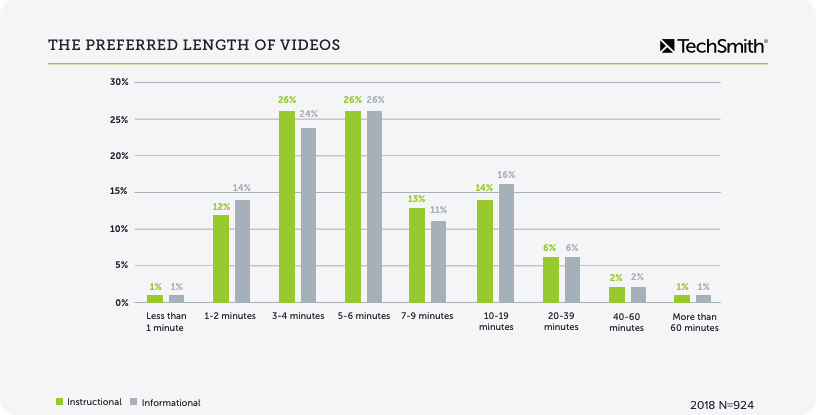
It’s a great practice to follow, considering the short attention span most people have. Besides, shorter videos load quicker on mobile devices.
However, a 3-6 minute video length is not enough for all video types. How-to, expertise videos, and product walkthroughs require more time to present information properly.
3) Follow the video marketing SEO rules
Making a creative video is not enough for marketing. If you want to engage more people, you also need to make your video more discoverable. That’s where search engine optimization steps in.
SEO video marketing involves:
- Metadata. Tune your meta title and meta description using keywords relevant to the topic of your video.
- Keyword-optimized video title and description. Use the main keywords in the actual title and description for Google to understand the intent of your video.
- Schema markup. Research semantic vocabulary and apply it to your video title, description, thumbnail, URL, video length, dimensions, and upload date.
You can additionally transcribe your video and optimize it for relevant keywords and improve your video’s discoverability.
4) Include an engaging CTA
It’s hard to imagine a marketing video without a call to action. After all, your goal is to inform the customer about the advantages of your product and encourage them to make the next move.
Not every video CTA is born equal. A highly converting CTA should have a set of the following five qualities:
- Verbal and visual appeal
- Clarity
- Emphasis on the viewers’ key needs
- Context-related
- Action-provoking
Don’t rely on the first CTA you come up with—always test it. You can run an A/B test to see how different groups of customers would react to various CTAs.
7 Key Metrics to Measure Your Video Marketing Campaign
Once you publish your marketing video, it’s time to track its performance and optimize it towards the goals you’ve set for it. The following seven metrics are essential in assessing the success of your video content marketing strategy.
1) View count
View count is the number of times someone watched your video. It’s a fundamental metric used to check your video’s popularity among the viewers.
If you have a YouTube channel, you can check total video views and for each video separately:

View count is useful if the goal of your video is to raise brand awareness. But keep in mind: each platform has a different definition of a view. On YouTube, a view is 30 seconds, while on Twitter, it should be more than 2 seconds.
2) Click-through rate
A click-through rate is the number of times a viewer clicked on your CTA divided by the time it has been viewed.
This metric is among the key ones for marketing videos – it helps you determine how well your CTA works towards the goal of the video. If the CTR is low, your call-to-action needs revisions.
3) Completions and completion rate
A video completion is the number of times a viewer watched a full video without skipping some of its parts.
On YouTube, you can check out the average view duration and how much in percentage an average viewer has watched your video. Key moments for audience retention with a chart are also available:
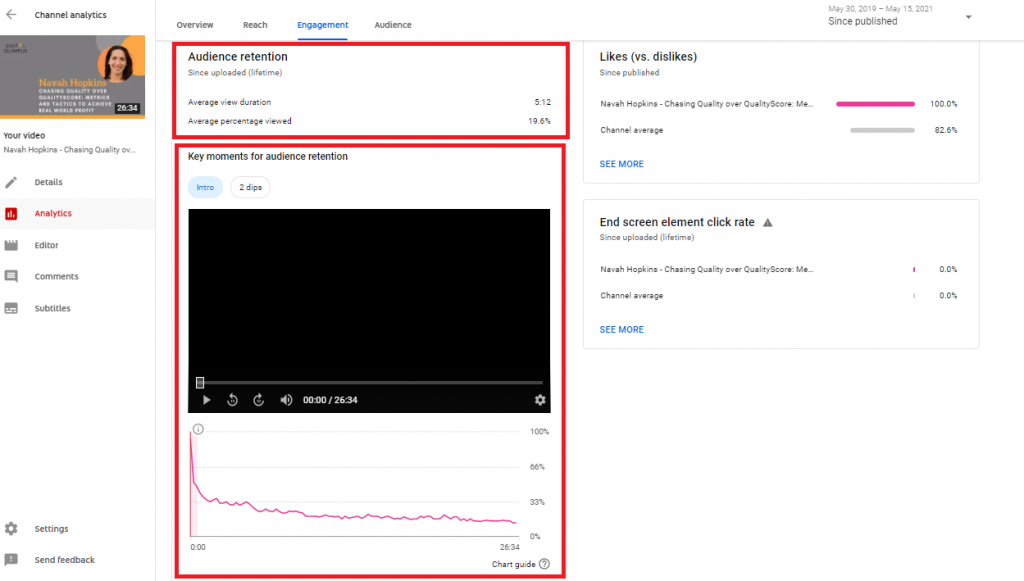
A completion rate is the number of viewers who watched your entire video divided by the number of people who played it.
Video completions are a more precise indicator of your video’s success. And if the completion rate is too low, then your video fails to cater to your audience’s interests.
4) Play rate
A play rate is the number of viewers who watched your video divided by all impressions your video received.
On Youtube, play rate is measured by comparing the total number of impressions (how many time people saw a video thumbnail) and impressions click-through rate (how many times people watched a video after seeing its thumbnail):

If your impressions CTR is too low, then you might have a problem with either the thumbnail, the title, or the video doesn’t match with your audience’s interests.
5) Audience activity
Audience activity is an engagement metric that shows the number of times your viewers interacted with your video. In online video marketing, audience activity includes comments, likes, dislikes, and shares.
If your video is on Youtube, you can check out comments, likes and dislikes:

You can’t track social shares via YouTube analytics, but you can do that with tools like HootSuite and SproutSocial.
6) Conversion rate
A conversion rate is the number of times viewers completed the desired action divided by the times they clicked on the video CTA. This metric is key in lead generation.
The conversion rate will depend on where you upload your video. If the goal is to boost signups for a free trial, then it makes sense to post your video on a corresponding landing page.
So, assess your conversion rate using a marketing tool of your choice. If it’s too low, consider relocating your video to a different distribution channel.
7) Source of traffic
The source of traffic metric shows you the traffic channels for your video.
On Youtube, you can easily track the traffic sources for each video:
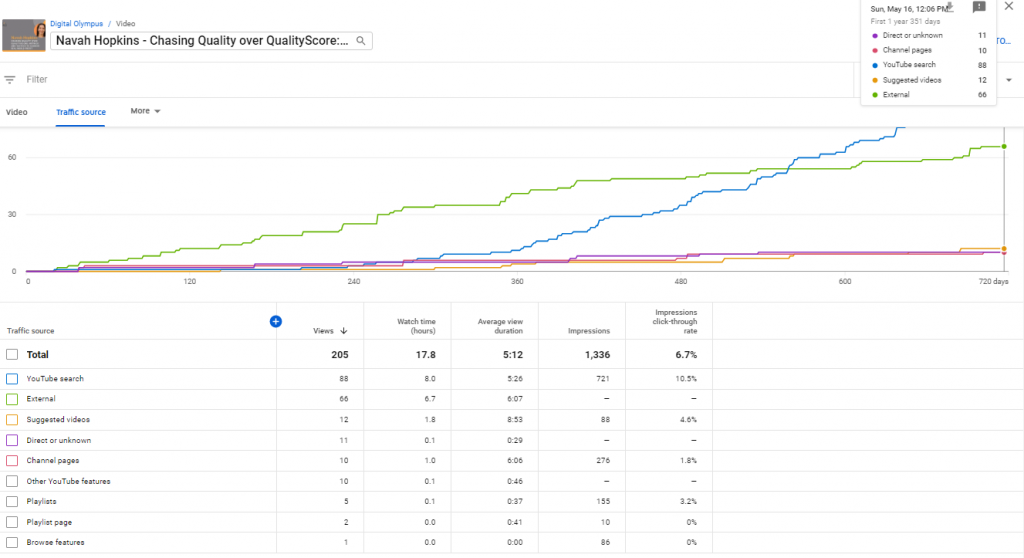
This metric can give you insights into the channels where your audience is the most active. As a result, you can incorporate these channels in your video marketing strategy and promote other videos there as well.
3 Video Marketing Trends in 2022
There’s no doubt that videos are here to stay. But how will the use of videos change next year?
Here are the top three online video marketing trends in 2022.
1) More focus on mobile videos
The demand for mobile videos has been growing for a while and will stay around in the upcoming years. This is because watching videos on mobile devices is more convenient than on desktops and TVs. Besides, the launch of Starlink (satellite Internet) will make mobile videos more accessible anywhere on earth.
From the standpoint of video marketing, mobile optimization has become a must. According to Facebook for Business, people are 1.5 times more likely to watch a video on mobile devices. Besides, mobile videos are popular among Millennials – they find mobile videos 1.35 times easier to focus on.
2) Live streaming keeps booming
Videos in marketing have taken many forms over the past few years, but live videos are the trend that might stay with us for a long time. The reason is obvious–the COVID-19 pandemic created a huge demand for this video format. Just in one weekend (May 13-14, 2020), the time spent on video streaming has increased by 44% in some countries.
Brands have many live streaming platforms to choose from – Twitch, YouTube, and social media platforms (Facebook Live, Instagram Live, TikTok, and Periscope). And it’s versatile, allowing you to stream product demonstrations, interviews, Q&A sessions, webinars, and many other types of marketing videos.
3) Prioritize silent videos
When scrolling YouTube Feed on your phone, you’ve probably noticed that videos start playing in silent mode. The same happens on social media channels like Facebook and Instagram.
According to Think with Google, the consumption of “quiet-time” videos has increased by 80%, and this format will remain relevant in the upcoming year. That’s why it’s crucial to make your videos with this trend in mind.
The simplest way to optimize your videos for the silent format is to add subtitles. This way, you also get to preserve the original message of your content.
Video Marketing Recap
Much like any other content strategy, video marketing is a creative outlet for your brand. But creativity alone will hardly bring any tangible results, like conversions, sales, brand awareness, etc.
That’s why you can’t overlook the importance of building a solid strategy before you start filming video content. A solid strategy will be your guide through the video creation process and help you make your videos meaningful.
Indeed, creating videos is labor-intensive. But is it worth trying? Absolutely! Videos are here to stay and undoubtedly belong to your digital marketing strategy. Besides, there’s nothing you can’t do now if you follow our extensive guide.
Need more resources on improving your video marketing strategy? Keep an eye on our blog for more articles like this.

Mariia is a content strategist and editor at Digital Marketer’s World. She is passionate about educating others on all things marketing and believes in the power of the written word.
